Bhutan
Introduction
Kingdom of Bhutan with an area of 38,394sqkm in South Asia is located in the eastern Himalayas sandwiched between China in the north & India in the south. These two countries are the largest population in the world & Bhutan with barely 7million population existing as a buffer zone, independent & sovereign country itself is a history and a miracle. Bhutan is a mountainous country with elevation rising from 100 meters to 7326 meters with more than 70 percent under forest cover. The country is relatively compact with a distance of 150 Kim’s from north to south & 300 Kim’s from east to west. Bhutan is world’s last Mahayana Buddhist kingdom. His majesty the fourth Druk gyelpo (king) Jigme Singye Wangchuck gifted democracy to the people. The first parliamentary elections was held in 2008. The economy of the country is largely dependent on Tourism & Hydropower. The GDP growth rate is 5.5 percent in 2019. Today, Bhutan is promoted as the last shangrila, land of gross national happiness, land of the peaceful dragon to the outside world. Bhutan is rated highly by the National Geography as one of the most sought tourists destiny in the world. The CNN has rated Bhutan as the most favorite tourist destination for 2021.
- Capital: Thimphu Population: 750,000
- National language: Dzongkha
- Currency: Ngultrum (Nu), where 1 USD is about Nu 82.86
- Country code: +975
- National sport: Archery
- National Dress: Men (Gho) Women (kira)
Name: Kingdom of Bhutan (Druk Gyal Khap in Dzongkha)
Area: 38,394 sq.km
Forest Coverage: 70%
Population: 770,276 (2023)
Official Language: Dzongkha
Currency: Ngultrum (Nu.)
Capital City: Thimphu
Local Time: Six hours ahead of UTC
Religion: Mahayana Buddhism
Political System: Democratic Constitutional Monarchy
National Tree: Cypress
National Flower: Blue Poppy
National Bird: Raven
National Animal: Takin
National Sport: Archery
National Dish: Ema Datshi (Chilies, either green or dried red chili stewed with traditional Bhutanese cheese)
Useful Bhutanese Phrases
Greetings / Hello: Kuzoo zangpo La
Welcome: Joen pa Leg So
Thank you: Kadrin Chhe La
Good wishes: Tashi Delek
Goodbye: Log Jay Gay (means we’ll meet again)
How are you?: Ga Day Bay Zhu Yoe Ga?
I’m fine: Nga Legshom Bay Rang Yoey la.
What is your name? (formal): Na gi Tshen Ga Chi Mo la?
What is your name? (informal): Chhoe gi Ming Ga Chi Mo?
My name is…: Nge gi Ming… Ein la.
Where are you from?: Chhoe ga te lay mo?
Yes: Ing la.
No: Men la.
Water: Chhu
Hot water: Chhu Tshe
Milk Tea: Na Ja
Butter Tea: Su Ja
Where is the toilet?: Chhabsang Ga Ti Mo?
Expensive!: Gong bom!
See you later: Shoo Lay Log Jay Ge
I like Bhutan: Nga Druk gai
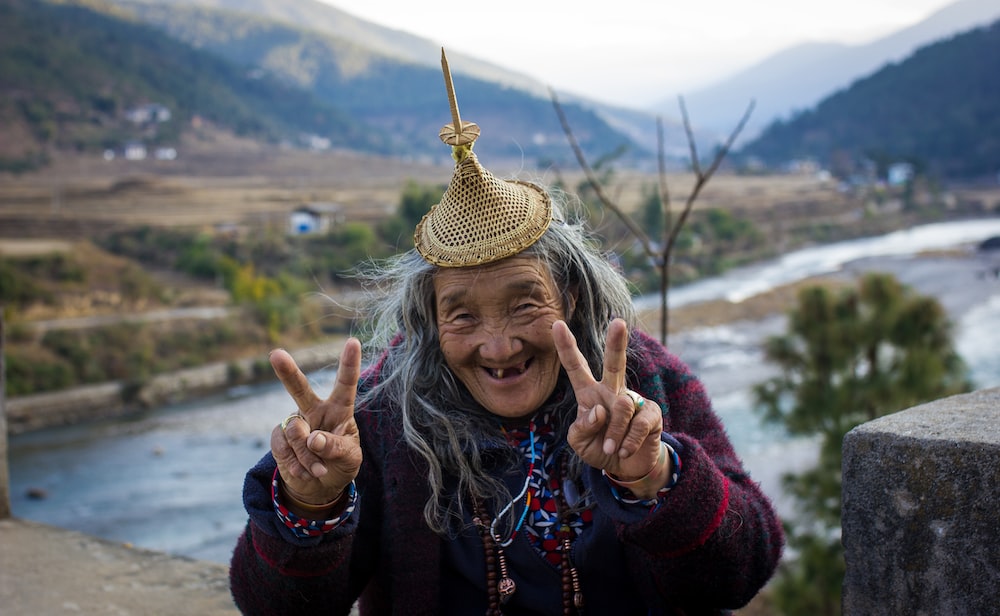
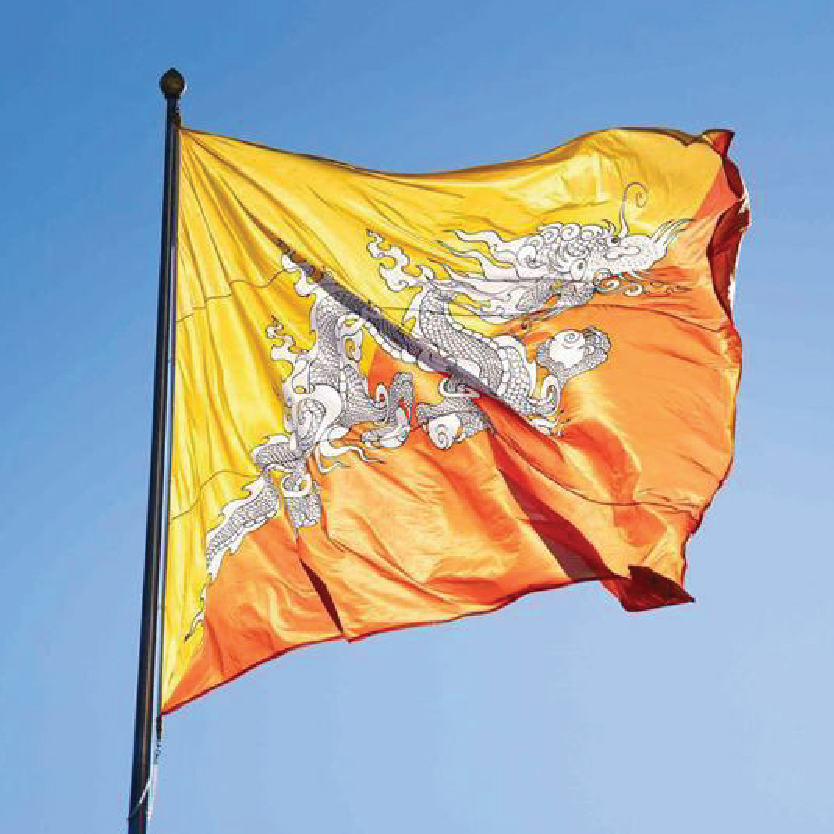
NATIONAL FLAG
Divided diagonally from the lower hoist-side corner to the upper fly-side corner; the upper triangle is yellow and the lower triangle is orange, with a white dragon holding four jewels in its claws cantered along the dividing line and facing away from the hoist.
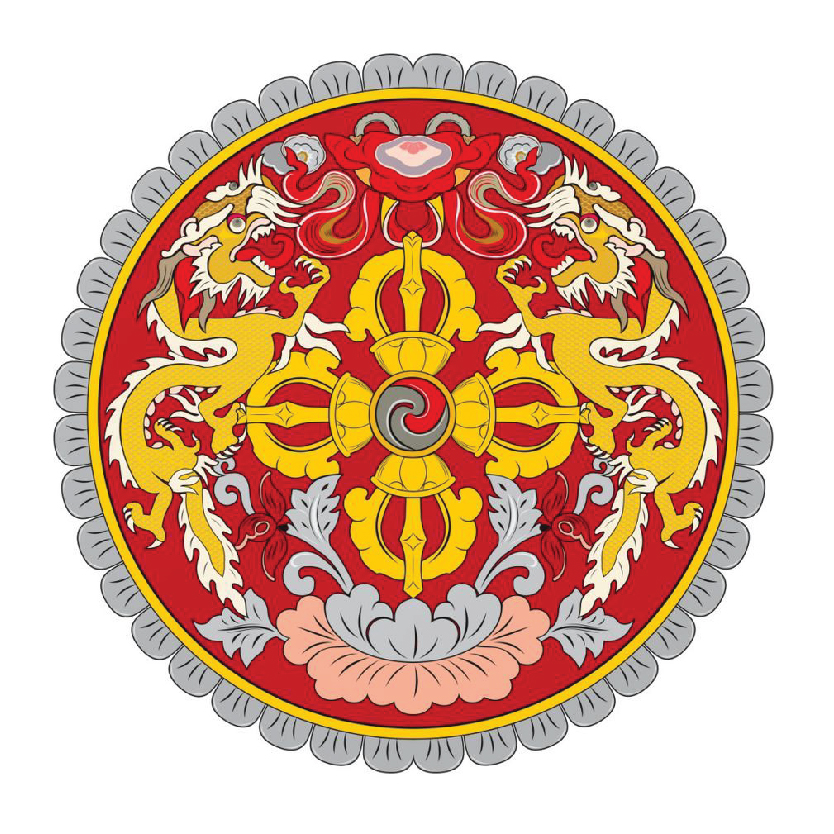
EMBLEM - ROYAL CREST
Druk Khatap or the Royal Crest of Bhutan has two dragons with a thunderbolt in the centre. It is the official seal and the National Emblem of Bhutan.
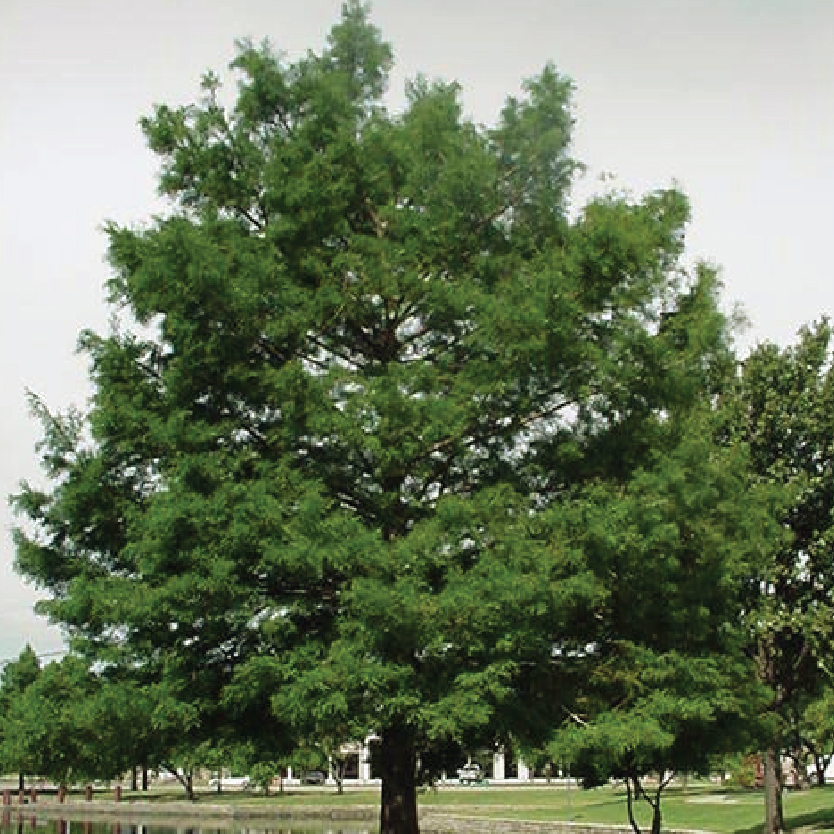
TREE - CYPRESS
The National Tree of Bhutan is locally known as 'Tsenden. It is also referred to as Bhutan Cypress or Himalayan Cypress.
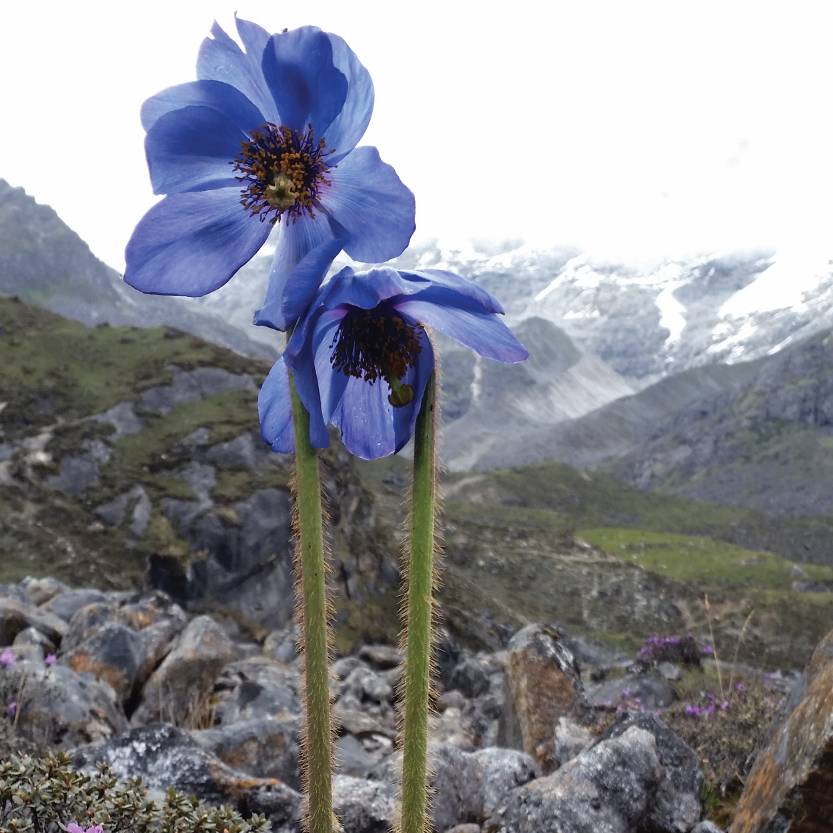
FLOWER - BLUE POPPY
The National Flower of Bhutan, is known locally as Euitgel Metog Hoem: Its biological name is Meconopsis grandis.
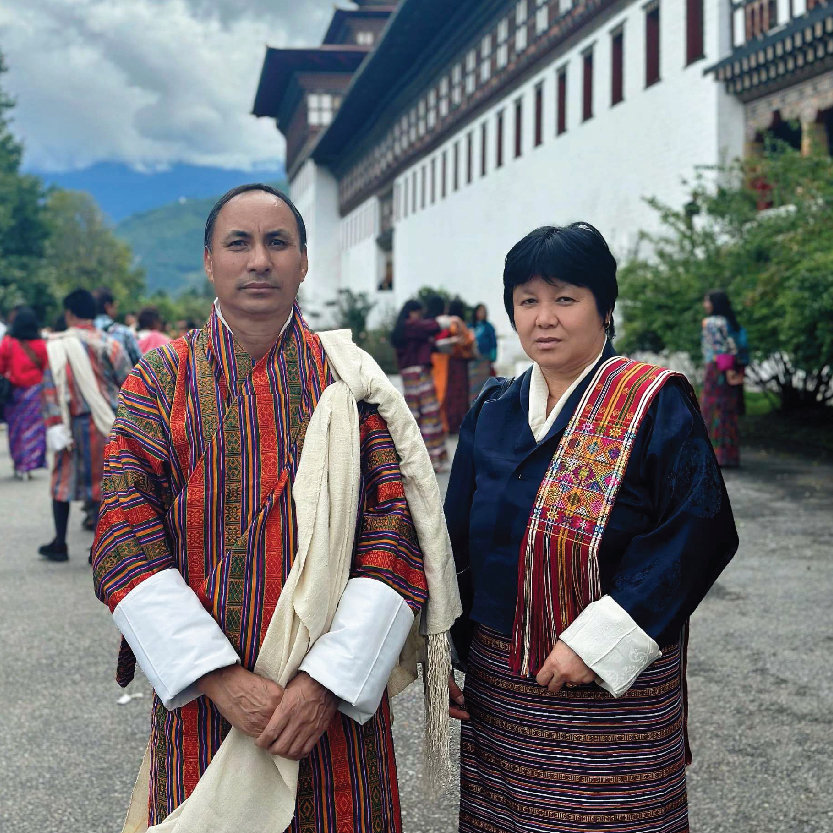
DRESS - KIRA & GHO
The 'Gho is the National Dress for men in Bhutan. National dress for Bhutanese women is Kira.

BIRD - RAVEN
The Raven is Bhutan's National Bird. It represents one of the most powerful deities of the country, Jarog Dongchen. Raven is thus known in the local language as 'Jarog.

ANIMAL - TAKIN
The Takin has been chosen as the National Animal because it is unique, rare and native to Bhutan.It is closely associated to religious history and mythology of the country.
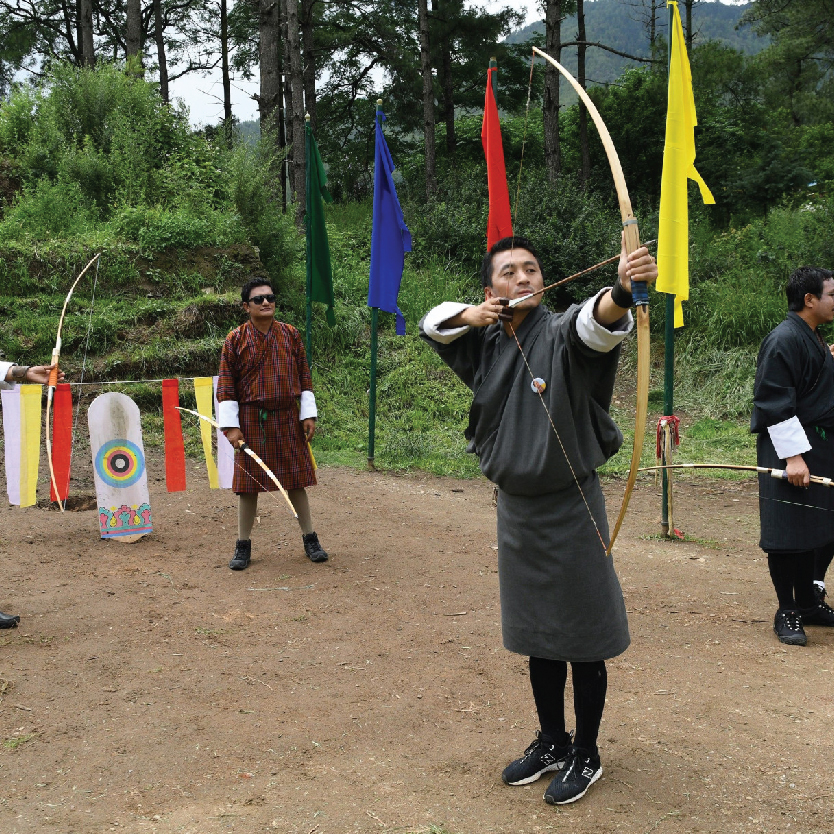
SPORT - ARCHERY
It is a sport played by men; but women do participate in this festival by dancing; accompanying the game and supporting their teams.
World Youngest Democracy Country
Bhutan became the world’s newest democracy, and symbolically, in the spring of 2008. In what was a historic moment for the country, the Bhutanese monarchy introduced constitutional democracy, 100 years since the hereditary monarchy was established in 1907 through an expression of confidence in the monarchy by way of election. Since then, the country has witnessed three democratic elections so far, the most recent being in 2018.
Buddhism & spiritualism
Bhutan is a spiritual nation. It is increasingly becoming known for its pure practice of Mahayana Buddhism, often referred to as the last bastion of tantric Buddhism. The influence of religion is evident in everyday lives of the people. The essence of the living faith manifests them- selves in the fluttering prayer flags on hills and high passes and the stupas and monuments that dot the countryside.
To understand Bhutan and its people, it is essential to have a basic understanding of Buddhism because Buddhist values define Bhutanese beliefs, customs and culture evinced in their daily lives. We can time and arrange for our guests to experience the partici- pate in our religious ceremonies and festivals that are observed and celebrated at different times of the year across the country.
FESTIVAL DATES 2024
| Festival Name | Festival Location | Festival Date |
| Lhamoi Dromche | Trongsa | Feb 15-17 |
| Punakha Drupchen | Punakha | Feb 16-18 |
| Punakha Tshechu | Punakha | Feb 19-21 |
| Tharpaling Thongdrol |
Chumi,Bumthang
|
Feb 24 |
| Tangsibi Mani |
Ura,Bumthang
|
Feb 24-26 |
| Bhutan International Marathon |
Annual Event Organised
|
Mar 5 |
| Gomphukora | Trashigang | Mar 17-19 |
| Talo Tshechu | Talo,Punakha | Mar 17-19 |
| Gasa Tshechu | Gasa | Mar 17-19 |
| Zhemgang Tshechu | Zhemgang | Mar 17-19 |
| Paro Tshechu | Paro | Mar 21-25 |
| Chhorten Kora | Trashiyangtse | Mar 25 & April 8 |
| Rhododendron festival | Lampelri Botanical Garden,Dochula | April 19-21 |
| Domkhar Tshechu | Chumi,Bumthang | April 18-20 |
| Ura Yakchoe | Ura,Bumthang | April 20-24 |
| Nimalung Tshechu | Chumi,Bumthang | June 14-16 |
| Kurjey Tshechu | Choekor,Bumthang | June 16 |
| Haa Summer Festival | Haa | July 14-15 |
| Mushroom festival | Genekha, Thimphu | Aug 15-16 |
| Masutaki Mushroom festival | Ura,Bumthang | Aug 23-24 |
| Tour of the Dragon-Bicycle Race | Bumthang-Thimphu | Sept 5 |
| Thimphu Drupchen | Thimphu | Sep 8 |
| Paro Dromche | Paro | Sep 10 |
| Wangdue Tshechu | Wangduephodrang | Sep 11-13 |
| Thimphu Tshechu | Thimphu | Sep 12-14 |
| Tamshing Phala Choepa | Tamshing,Bumthang | Sep 13-15 |
| Gangtey Tshechu | Gangtey, Phobjikha Valley | Sep 16-18 |
| Thangbi Mani | Choekor,Bumthang | Sep 17-19 |
| Jhomolhari Mountain Festival | Dangochang (Jhomolhari Base Camp) | Oct 14-15 |
| Royal Highland festival | Oct 23-24 | |
| Chukha Tshechu | Chukha | Oct 10-12 |
| Jakar Tshechu | Choekor,Bumthang | Oct 10-12 |
| Jambhay Lhakhang Drup | Choekor,Bumthang | Oct 17-21 |
| Prakhar Duchhoed | Chumi,Bumthang | Oct 18-20 |
| Dechenphu Tshechu | Thimphu | Nov 3 |
| Black Neckedl Crane festival | Phobjikha Valley | Nov 11 |
| Goenpi Dromche | Trongsa | Nov 6-8 |
| Mongar Tshechu | Mongar | Nov 9-11 |
| Trashigang Tshechu | Trashigang | Nov 9-11 |
| Jambhay Lhakhang Singye Cham | Bumthang | Nov 15 |
| Pemagatshel Tshechu | Pema Gatshel | Nov 9-11 |
| Nalakhar Tshechu | Bumthang | Nov 15-17 |
| Druk Wangyel Tshechu | Dochula | Dec 13 |
| Trongsa Tshechu | Trongsa | Dec 8-10 |
| Lhuentse Tshechu | Lhuentse | Dec 8-10 |
